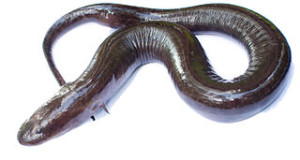 Lengthening days and warmer temperatures are beginning to register on amphibian pets nationwide, stirring long-dormant breeding urges. Last week I was please to find that a 2 year old female axolotl (Ambystoma mexicanum) which I paired with an older male had produced eggs for the first time. A week or so earlier a reader informed me of another spontaneous axolotl breeding.
Lengthening days and warmer temperatures are beginning to register on amphibian pets nationwide, stirring long-dormant breeding urges. Last week I was please to find that a 2 year old female axolotl (Ambystoma mexicanum) which I paired with an older male had produced eggs for the first time. A week or so earlier a reader informed me of another spontaneous axolotl breeding.
Mexican axolotls are an ideal choice for the prospective amphibian breeder, and are becoming ever more popular each year. With spring upon us, I thought I might pass along some photos of my pair and their eggs, along with a few tips.
The Aquarium and Filter
The eggs pictured here are set up in a PLA House Plastic Cage equipped with a Small World Filter. PLA House Cages are available in 6 sizes, and their light weight allows for easy water changes. I have found them indispensible in my collection, and always have a number on hand.
The Small World Filter is ideal for use with amphibian larvae, as the water return is directed upwards and so does hamper weak swimmers. Sponge filters work equally well. I use an air pump that provides just enough aeration to keep the eggs slightly in motion.
Providing Cover
 Axolotl eggs are typically attached to plants or other structures, as seen in the accompanying photo. Once they begin to hatch, I’ll add additional plants, nearly filling the tank so as to separate the larvae a bit and reduce cannibalism. Plastic plants set in bases are very useful, as they provide shelter throughout the water column. The Cypress Mat provides excellent cover on the bottom of the aquarium, where the larvae will be spending most of their time.
Axolotl eggs are typically attached to plants or other structures, as seen in the accompanying photo. Once they begin to hatch, I’ll add additional plants, nearly filling the tank so as to separate the larvae a bit and reduce cannibalism. Plastic plants set in bases are very useful, as they provide shelter throughout the water column. The Cypress Mat provides excellent cover on the bottom of the aquarium, where the larvae will be spending most of their time.
Feeding Axolotl Larvae
Finely chopped live blackworms form the basis of my diet for newly hatched larvae…a worm feeder lessens the likelihood of the worms clumping together (larvae often choke while trying to swallow large balls of worms). A brine shrimp hatchery is also useful, and larvae can sometimes be induced to accept freeze dried daphnia and other invertebrates as well.
Further Reading
Pleased see my article Breeding Mexican Axolotls for additional breeding recommendations.
 That Reptile Blog – Reptile, Amphibian and Exotic Pet Care and Information
That Reptile Blog – Reptile, Amphibian and Exotic Pet Care and Information



really good info I want 2 get a pair of axolotls and breed them and i’m going 2 turn 13 so i hope i get them 4 my b day 🙂
Hello Vanessa, Frank Indiviglio here.
Thanks for the kind words; I’m glad you enjoyed the article. Please check this article for more information on axolotl care, and feel free to write back. I hope you get your wish!
Happy Birthday!
Best regards, Frank Indiviglio